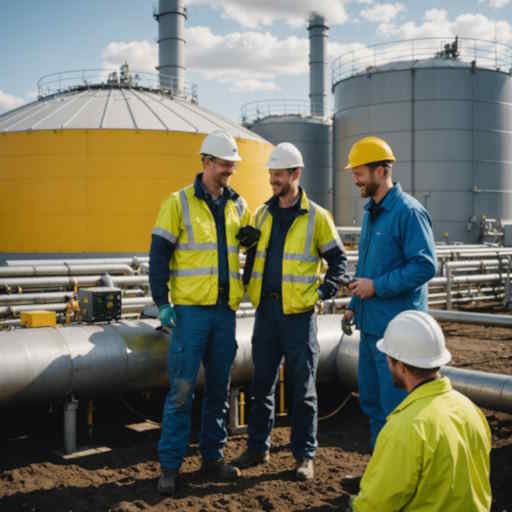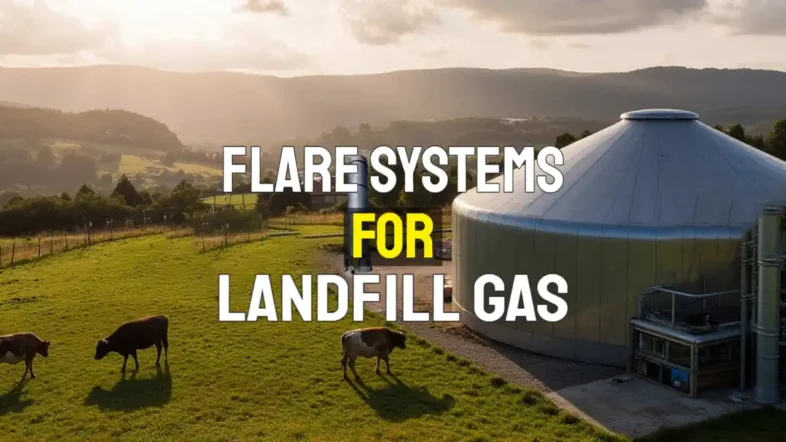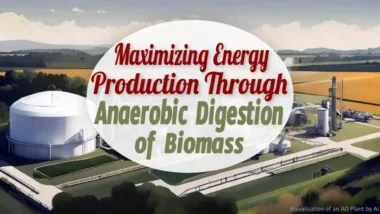Did you know up to 50% of landfill emissions are methane—a greenhouse gas 25 times more potent than CO₂ as a climate change driver? As the world intensifies its fight against climate change, driven by initiatives like the COP Global Methane Pledge, landfill operators face mounting pressure to adopt advanced flare systems for landfill gas.
Not only are national and local regulations stricter than ever in 2024, but rising global temperatures make the reduction of greenhouse gas emissions from landfill sites a pressing environmental and business imperative.
This article guides you through the leading flare system technologies, how they enable compliance, and why choosing the right system is critical for environmental stewardship and operational success.
Addressing Climate Commitments: The Role of Flare Systems for Landfill Gas in Environmental Compliance
“With over 50% of landfill emissions made up of methane—a greenhouse gas 25 times more potent than CO₂—effective flare systems for landfill gas are not just regulatory; they’re a climate imperative.”
In 2025, flare systems for landfill gas have emerged as vital tools in fulfilling climate commitments, especially under the banner of the COP Global Methane Pledge. Methane, a byproduct of organic waste decomposition in landfills, poses a greater threat to the atmosphere than carbon dioxide due to its elevated heat-trapping capacity.
As a response, authorities worldwide have tightened the web of environmental regulations mandating strict methane control, compelling landfill operators to integrate reliable gas flaring solutions into everyday waste management practices.
Modern landfill gas flares not only meet compliance but also significantly contribute to curbing global warming. Efficient flaring technology captures and combusts methane, converting it into less harmful CO₂ and thus slashing a landfill’s greenhouse gas footprint.
These solutions range from advanced enclosed flare systems to highly portable units, all engineered to suit varying landfill sizes and operational conditions.
By adopting best-fit flare systems, operators can both avoid hefty non-compliance fines and position themselves as leaders in environmental responsibility, aligning with national and global efforts to limit temperature rises and meet future climate pledges.
What You’ll Learn About Flare Systems for Landfill Gas
- Key types of flare systems for landfill gas and their features
- How landfill gas flaring enhances compliance and reduces environmental impact
- Ranking of leading flare system technologies in 2024
- Common challenges, costs, and maintenance requirements
- Expert insights into regulatory trends and best practices
Top 4 Flare Systems for Landfill Gas: Technologies Transforming Compliance
- Enclosed Flare Systems: Meeting Stringent Air Quality Laws
- Biogas Flare Systems: Integration with Renewable Gas Recovery
- High-Temperature Flare Systems: Maximising Methane Destruction Efficiency
- Portable Landfill Gas Flare Units: Flexibility on Site
1. Enclosed Flare Systems for Landfill Gas
- Principle of operation and design
- Emission reduction effectiveness
- Use cases and regulatory drivers
Enclosed flare systems are engineered for optimal methane destruction and comprehensive emissions control in landfill environments. Utilising a sealed combustion chamber, these units ensure that landfill gas—comprised mainly of methane and carbon dioxide—is burned at high temperatures and contained within a robust structure.
This advanced design not only improves combustion efficiency for greenhouse gases but also minimises the release of odorous compounds and visible flame, addressing both environmental concerns and community sensitivities around landfill sites.
With typical destruction efficiencies surpassing 98%, enclosed landfill gas flares set the benchmark for regulatory compliance, meeting or exceeding requirements instituted by local and national authorities—notably those shaped by the latest climate policies.
These systems are typically equipped with automated control system features, allowing landfill operators to monitor flare performance and ensure uninterrupted compliance. Their effectiveness makes them a common requirement for sites located near urban areas, sensitive ecosystems, or any region with rigorous air quality standards.
2. Candlestick Flare Systems for Landfill Gas
- Basic design and low-cost advantage
- Limitations under the new emission guidelines that apply in many nations
The candlestick flare—often referred to as an open flare or flare stack—is a simple, durable solution for combusting landfill gas. Its straightforward design, featuring an elevated vertical pipe with an exposed burner, offers clear advantages in initial cost and ease of installation.
Candlestick flares are typically used for managing lower volumes of landfill gas or as a backup to primary enclosed systems. Their visibility and immediate operational feedback appeal to operators seeking reliability.
However, the absence of an enclosure means emissions are not well controlled, with increased risks of incomplete combustion, smoke, and fugitive methane. Recent updates in air quality legislation are making open candlestick flares less viable in urban or environmentally sensitive areas.
In 2025, landfill operators must weigh these systems’ low CapEx against their inability to guarantee high efficiency and meet tightening emission standards, especially as the use of enclosed flares becomes increasingly mandated by law.
3. Biogas Flare Systems and Landfill Gas Recovery
- Integration with gas-to-energy projects
- Environmental compliance highlights
Biogas flare systems are enclosed flare systems, central to landfills investing in circular economy initiatives. These systems are integrated with gas collection and energy recovery units that capture and utilise the energy content of landfill gas—often through electricity generation or direct use as renewable biogas.
Any excess or unusable gas is then safely flared, ensuring environmental compliance. This dual purpose not only maximises the valorisation of valuable energy resources but also guarantees that greenhouse gases are not vented directly into the air.
The incorporation of flare systems within biogas recovery projects aligns closely with the newest emissions legislation and sustainable waste management objectives. Biogas flares are designed to adapt to fluctuating gas volumes and composition, enabling consistent performance and compliance even as landfill dynamics change.
Operators benefit from improved environmental reporting, potential eligibility for renewable energy credits or incentives, and a bolstered reputation for sustainability leadership in the waste sector.

4. Utility Flare Systems for Landfill Gas Management
- Capacity to handle fluctuating landfill gas flows
- Cost and operational factors
Utility flare systems are engineered to accommodate the inconsistent gas flows that characterise many landfill sites. Fluctuations in waste input, moisture content, and organic decomposition can result in variable gas output, demanding a flare system with reactive control systems and robust operational flexibility.
Utility flares offer a balanced option: they provide reliable methane destruction while incorporating adaptable control mechanisms that maintain compliance regardless of changes in landfill gas production.
From a cost standpoint, utility flares strike an optimal balance between upfront investment and ongoing operating expenses. Their design simplifies maintenance, and many units integrate smart sensors for automatic modulation of combustion parameters.
For landfill operators in regions with moderate but unpredictable waste volumes, these flares offer a compliant, budget-conscious choice that readily adapts to daily operational variabilities.
5. High-Temperature Landfill Gas Flare Systems
- Achieving near-total methane destruction
- Best applications and regulatory alignment
As regulations around methane tighten, high-temperature flare systems have become essential for sites requiring nearly complete greenhouse gas elimination. These flares operate at temperatures above 1,000°C, with a specified minimum residence time at that temperature, ensuring destruction efficiencies of 99% or more—a necessity for landfill sites subject to the most demanding air quality laws.
Advanced insulation, fail-safe ignition, and real-time monitoring are typically standard, ensuring regulatory alignment and safeguarding surrounding communities from harmful emissions.
This technology is best suited for large-scale landfills or those under strict permitting regimes.
While high initial costs are common, the operational savings from avoided regulatory penalties and the enhanced reputational value of high-performance emissions control often justify the investment.
Their use is also strongly recommended in environmentally sensitive areas or locations seeking international certifications for sustainability performance.
6. Portable Landfill Gas Flare Units
- On-demand flare deployment
- Emergency and temporary use
Portable landfill gas flare units have revolutionised on-site waste management, offering rapid, flexible solutions for handling gas emissions during construction, well maintenance, or emergency conditions.
These self-contained units can be easily moved across the landfill, deployed for temporary gas streams, or used to supplement permanent flare infrastructure during periods of peak demand or renovation.
Design advantages include lightweight framing, quick-connect gas fittings, and autonomous operational controls.
Their use minimises downtime, prevents unplanned methane release during landfill upgrades, and provides a contingency resource for regulatory compliance.
For landfill operators managing dynamic projects or phased expansions, portable flares are an indispensable component of modern gas management strategy.
7. Enclosed Landfill Gas Flares for Urban and Sensitive Sites
- Noise, odour, and visual impact mitigation
- Meeting local urban air quality ordinances
In an era of increased urban development and environmental scrutiny, specialised enclosed landfill gas flares are purpose-built for locations where public perception and stringent municipal regulation converge. These flares feature sound-dampening insulation, odour filtration, and architectural shrouding to blend with surroundings and reduce community disturbance. Their precision combustion chambers eliminate visual flame and smoky emissions, making them ideal for municipal, peri-urban, or sensitive ecological settings.
Beyond environmental performance, these flares help operators achieve seamless compliance with evolving local ordinances and COP Global Methane Pledge requirements. Investing in urban-ready flare technology is both a regulatory obligation and a proactive strategy to sustain your site’s operation amid growing neighbourhood and city council expectations.
Comparison Table: Specifications of Common Flare Systems for Landfill Gas
| Flare System Type | Emission Control Effectiveness | Typical Cost Range (£) | Key Regulatory Certifications | Footprint | Maintenance Frequency |
|---|---|---|---|---|---|
| Enclosed Flare | 98%–99%+ methane destruction | £50–£200k | EN 60079, MCERTS, UK-EA, EU WID/IED | Medium | Quarterly/Automated monitoring |
| Candlestick Flare | 80%–95% | £10–£30k | Basic local/Not permitted by UK-EA | Small | Annual/manual |
| Biogas Flare | 95%–98% | £40–£120k | EN 60079, MCERTS, EU RED, Ofgem | Medium | Quarterly/with gas-to-energy checks |
| Utility Flare | 92%–98% | £20–£80k | UK-EA, MCERTS | Medium | Biannual |
| High-Temperature Flare | 99%+ | £80–£250k | EN 60079, MCERTS, EU IED | Large | Monthly/automated |
| Portable Flare | 85%–95% | £15–£40k | UK-EA, site-specific | Small/Moveable | On deployment |
| Urban Enclosed Flare | 99%+ | £120–£300k | EN 60079, MCERTS, Local AQ | Medium | Quarterly/proactive |
How Flare Systems for Landfill Gas Work: Operational Principles Explained
How does a landfill gas flare work?
- Purpose of landfill gas collection and flaring
- Combustion principles and destruction efficiency
- Monitoring and control
Landfill gas flare systems serve the essential role of capturing and safely burning methane and other volatile organic compounds generated during waste decomposition.
The primary objective is to prevent fugitive emissions—uncontrolled releases contributing to atmospheric pollution—by directing the gas through pipes into a controlled burn chamber or flare stack. Inside the flare, a carefully managed combustion process converts the highly potent methane into less impactful CO₂ and water vapour, achieving high destruction efficiencies (often above 98% in enclosed systems).
Reliable monitoring and control system integration are critical for ongoing compliance. Sensors measure gas composition, pressure, and temperature, automatically adjusting the flare’s operation to maintain optimal performance.
Many modern systems provide remote diagnostics or cloud-based performance dashboards, ensuring landfill operators can respond quickly to any fluctuations and guarantee their landfill site remains aligned with all regulatory and environmental goals.
How does a flare gas recovery system work?
- Separation of recoverable components
- Energy valorisation before flaring residue
- Benefits to landfill operators
In a flare gas recovery system, raw landfill gas is first collected and passed through a separation unit that extracts usable methane and other valuable gases. These are channelled to energy valorisation processes such as electricity generation or direct pipeline injection, leveraging the renewable potential of biogas generated from waste. Only the surplus or non-recoverable portion of the gas is then routed to the flare for destruction.
This approach enhances overall site efficiency—transforming a compliance obligation into a revenue stream—while minimising the volume of gas subject to high-temperature flaring. Landfill operators benefit both economically and environmentally by maximising resource utilisation and reducing the overall environmental impact of waste management.
Economic Insights: Cost of Flare Systems for Landfill Gas
How much does a gas flare cost?
- Factors influencing project costs
- CapEx vs. OpEx for different flare designs
- Grants and incentives
The cost of implementing flare systems for landfill gas varies depending on design, capacity, and regulatory requirements. Basic candlestick flares may cost as little as £10,000–£30,000, while high-specification enclosed or urban-ready systems can run from £120,000 to over £300,000.
Project complexity, such as integration with gas recovery units or advanced control systems, will drive costs higher. Capital expenses (CapEx) include procurement and installation, while operational expenditures (OpEx) cover maintenance, monitoring, and repairs.
Long-term OpEx can be minimised through automation, proactive service routines, and remote diagnostics, making the use of advanced flares not only compliant but cost-efficient.
Grants and incentives—often targeting renewable energy projects or methane reduction—can significantly offset both CapEx and OpEx, especially for flares paired with biogas valorisation.
Operators are advised to investigate local funding schemes, government sustainability initiatives, and European emissions reduction incentives to optimise investment.
Barriers and Disadvantages of Flaring Landfill Gas
What are the disadvantages of flaring gas?
- Incomplete methane destruction risks
- Formaldehyde and particulate emissions
- Alternatives to flaring: upgrading, utilisation
Despite their environmental and compliance benefits, landfill gas flare systems come with notable challenges. Incomplete combustion in poorly maintained or basic systems risks methane slip and the formation of other pollutants like formaldehyde and particulates, especially in open or candlestick flares.
Certain operational scenarios—such as irregular gas flows or unsuitable gas composition—can reduce system efficiency, cause system cut-out events, and undermine environmental gains.
Moreover, flaring is inherently a waste process: valuable energy resources are lost as heat instead of being used or sold as renewable biogas.
As technology advances, the emphasis is shifting towards biogas recovery, upgrading, and utilisation for energy production. Operators should regularly evaluate whether flaring or alternative valorisation best meets evolving regulatory, environmental, and economic objectives.
Best Practice Tips for Landfill Gas Flares
- Choosing flare systems compatible with site specifics
- Ensuring compliance with local, national, and COP Global Methane Pledge requirements
- Routine inspections and remote monitoring for operational reliability
To maximise the value and compliance of flare systems for landfill gas, system selection must match the landfill site’s gas flow, location, and regulatory landscape. Urban or sensitive sites almost always require enclosed flares with advanced controls, while rural locations handling low-volume emissions might opt for cost-effective candlestick designs.
Checking regulatory certifications and aligning with the latest guidance ensures operators aren’t caught out by shifting rules under national law or ambitious international pledges like COP’s methane reduction targets.
Operational reliability hinges on routine inspections, remote monitoring, and maintenance tailored to the flare’s complexity and workload.
Proactive service schedules, immediate response to diagnostic alerts, and using only certified contractors for repairs all play crucial roles in delivering continuous environmental compliance and long-term operational savings.

Expert Quote: Trends and Regulatory Changes
“Regulators in 2025 demand precise emissions control—advanced flare systems for landfill gas are vital for continued landfill operation.”
Key Takeaways: Flare Systems for Landfill Gas and Future Compliance
- Flare systems for landfill gas are central to meeting new methane regulations.
- Technological advancements are making flaring cleaner and more efficient.
- Site-specific system selection and regular maintenance maximise compliance and operational savings.
Frequently Asked Questions (FAQs) on Flare Systems for Landfill Gas
- When should you choose an enclosed vs. a candlestick flare?
Enclosed flares are preferred for urban, sensitive, or regulation-heavy sites due to superior emissions control, reduced noise, and unseen flame. Candlestick flares appeal where regulations are less intense, volumes are low, or cost is a key driver. Always confirm with the latest regulatory guidance. - What certifications do landfill gas flare systems require?
Typical certifications include EN 60079, MCERTS, UK-EA, and compliance with the EU Waste Incineration Directive (WID) or Industrial Emissions Directive (IED). Verify local authority requirements and regularly audit your certifications for continuing compliance. - What is the expected lifespan for a landfill gas flare?
Most properly maintained flare systems offer 15–25 years of operational life. Lifespan depends on flare type, gas composition, maintenance diligence, and operational workload. Regular inspections extend functional life and ensure reliable environmental performance.
Conclusion: Selecting the Right Flare Systems for Landfill Gas—Next Steps for Compliance
Investing in site-appropriate flare systems for landfill gas is essential for meeting current and future environmental requirements, protecting public health, and ensuring your landfill’s operational continuity.
For an in-depth Guide to Landfill Gas Flare System Selection and Installation, Check Out our ebook here: https://lastraddie.gumroad.com/l/landfillgasflarehandbook
Sources
- UK Environment Agency – Guidance for the Landfill Sector
- Global Methane Initiative – About Landfill Methane
- European Commission – Landfill Directive
- US EPA – Landfill Methane Outreach Program
- Example Site – https://example.com
To deepen your understanding of flare systems for landfill gas and their role in environmental compliance, consider exploring the following resources:
- “Landfill Gas Primer – Chapter 5: Landfill Gas Control Measures” by the Agency for Toxic Substances and Disease Registry (ATSDR) provides an in-depth look at various landfill gas control measures, including the efficiency and operational considerations of different flare types. (atsdr.cdc.gov)
- “Flare Systems” by John Zink offers insights into advanced flaring technologies designed for safety, reliability, and efficiency in managing landfill and biogas emissions. (johnzink.com)
These resources will provide you with comprehensive information on the selection, operation, and environmental impact of flare systems in landfill gas management.




